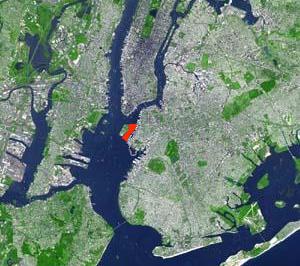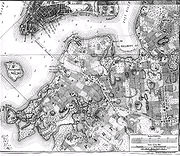
Buttermilk Channel
Encyclopedia



New York City
New York is the most populous city in the United States and the center of the New York Metropolitan Area, one of the most populous metropolitan areas in the world. New York exerts a significant impact upon global commerce, finance, media, art, fashion, research, technology, education, and...
, Buttermilk Channel is a small tidal strait
Strait
A strait or straits is a narrow, typically navigable channel of water that connects two larger, navigable bodies of water. It most commonly refers to a channel of water that lies between two land masses, but it may also refer to a navigable channel through a body of water that is otherwise not...
in Upper New York Bay
Upper New York Bay
Upper New York Bay, or Upper Bay, is the traditional heart of the Port of New York and New Jersey, and often called New York Harbor. It is enclosed by the New York City boroughs of Manhattan, Brooklyn, and Staten Island and the Hudson County, New Jersey municipalities of Jersey City and Bayonne.It...
, approximately one mile long and one-fourth of a mile wide (1.6 by 0.4 km), separating Governors Island
Governors Island
Governors Island is a island in Upper New York Bay, approximately one-half mile from the southern tip of Manhattan Island and separated from Brooklyn by Buttermilk Channel. It is legally part of the borough of Manhattan in New York City...
from Brooklyn
Brooklyn
Brooklyn is the most populous of New York City's five boroughs, with nearly 2.6 million residents, and the second-largest in area. Since 1896, Brooklyn has had the same boundaries as Kings County, which is now the most populous county in New York State and the second-most densely populated...
.
Origins of the name are uncertain but it is alleged to be a reference to the dairy farmers who used to cross this channel by boat to sell their milk in Manhattan markets. Some people believe that the channel got its name because crossing it was so rough that the farmers' milk was churned in to butter by the time they reached Manhattan. According to another legend, before the channel was dredged to accommodate cargo ships, cows were walked across it at low tide to graze on Governor's Island. In his newspaper articles about Brooklyn history, Walt Whitman
Walt Whitman
Walter "Walt" Whitman was an American poet, essayist and journalist. A humanist, he was a part of the transition between transcendentalism and realism, incorporating both views in his works. Whitman is among the most influential poets in the American canon, often called the father of free verse...
wrote of a time "as late as the Revolutionary War
American Revolutionary War
The American Revolutionary War , the American War of Independence, or simply the Revolutionary War, began as a war between the Kingdom of Great Britain and thirteen British colonies in North America, and ended in a global war between several European great powers.The war was the result of the...
(when) cattle were driven across from Brooklyn, over what is now Buttermilk Channel, to Governors Island." In the bitter volcanic winter
Volcanic winter
A volcanic winter is the reduction in temperature caused by volcanic ash and droplets of sulfuric acid obscuring the sun and raising Earth's albedo after a large particularly explosive type of volcanic eruption...
of 1817— the volcanic winter
Volcanic winter
A volcanic winter is the reduction in temperature caused by volcanic ash and droplets of sulfuric acid obscuring the sun and raising Earth's albedo after a large particularly explosive type of volcanic eruption...
following the "Year Without a Summer
Year Without a Summer
The Year Without a Summer was 1816, in which severe summer climate abnormalities caused average global temperatures to decrease by about 0.4–0.7 °C , resulting in major food shortages across the Northern Hemisphere...
"— when the thermometer dropped to -26 °F, the waters of the Upper Bay froze so hard that horse-drawn sleighs were driven across Buttermilk Channel to Governors Island.
On the Brooklyn side, modern development started in the 1840s, when the Atlantic Basin
Atlantic Basin
The Atlantic Basin is the Atlantic Ocean.Atlantic Basin may also refer to:* Atlantic Basin Iron Works, an ironworks that operated in Brooklyn, New York, in the early to mid-20th century...
and docks, and the Erie Basin were started. The former is now the Red Hook Container Port and the Brooklyn Cruiseship Terminal, while the latter is now the site of the Brooklyn IKEA.
In 1902 the channel was dredged extensively by the U.S. Army Corps of Engineers. With current charted depths of 35 to 40 ft (10.7 to 12.2 m), Buttermilk Channel is still a busy shipping lane offering the most convenient access to the Brooklyn waterfront.
Until the late 20th century the primary user of the channel was the U.S. Coast Guard, which had a local headquarters on Governor’s Island.
The channel is marked by a number of navigation aids (green cans no. 5 and 7 at the NE entrance, and green gong no. 1, marking low water off the tip of Governors Island). Tidal currents on the channel are rather strong.

